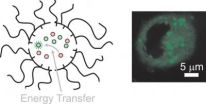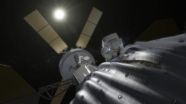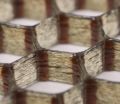(Press-News.org) VIDEO:
Francisco Raymo discusses his work in this video.
Click here for more information.
CORAL GABLES, Fla. (June 25, 2014) — With the continuing need for very small devices in therapeutic applications, there is a growing demand for the development of nanoparticles that can transport and deliver drugs to target cells in the human body.
Recently, researchers created nanoparticles that under the right conditions, self-assemble – trapping complementary guest molecules within their structure. Like tiny submarines, these versatile nanocarriers can navigate in the watery environment surrounding cells and transport their guest molecules through the membrane of living cells to sequentially deliver their cargo.
Although the transport of molecules inside cells with nanoparticles has been previously achieved using various methods, researchers have developed nanoparticles capable of delivering and exchanging complementary molecules. For practical applications, these nanocarriers are highly desirable, explains Francisco Raymo, professor of chemistry in the University of Miami College of Arts and Sciences and lead investigator of this project.
"The ability to deliver distinct species inside cells independently and force them to interact, exclusively in the intracellular environment, can evolve into a valuable strategy to activate drugs inside cells," Raymo says.
The new nanocarriers are15 nanometers in diameter. They are supramolecular constructs made up of building blocks called amphiphilic polymers. These nanocarriers hold the guest molecules within the confines of their water-insoluble interior and use their water-soluble exterior to travel through an aqueous environment. As a result, these nanovehicles are ideal for transferring molecules that would otherwise be insoluble in water, across a liquid environment.
"Once inside a living cell, the particles mix and exchange their cargo. This interaction enables the energy transfer between the internalized molecules," says Raymo, director of the UM laboratory for molecular photonics. "If the complementary energy donors and acceptors are loaded separately and sequentially, the transfer of energy between them occurs exclusively within the intracellular space," he says. "As the energy transfer takes place, the acceptors emit a fluorescent signal that can be observed with a microscope."
Essential to this mechanism are the noncovalent bonds that loosely hold the supramolecular constructs together. These weak bonds exist between molecules with complementary shapes and electronic properties. They are responsible for the ability of the supramolecules to assemble spontaneously in liquid environments. Under the right conditions, the reversibility of these weak noncovalent contacts allows the supramolecular constructs to exchange their components as well as their cargo.
The experiments were conducted with cell cultures. It is not yet known if the nanoparticles can actually travel through the bloodstream.
"That would be the dream, but we have no evidence that they can actually do so," Raymo says. "However, this is the direction we are heading."
The next phase of this investigation involves demonstrating that this method can be used to do chemical reactions inside cells, instead of energy transfers.
"The size of these nanoparticles, their dynamic character and the fact that the reactions take place under normal biological conditions (at ambient temperature and neutral environment) makes these nanoparticles an ideal vehicle for the controlled activation of therapeutics, directly inside the cells," Raymo says.
The current study is titled "Intracellular guest exchange between dynamic supramolecular hosts." It's published in the Journal of the American Chemical Society. Other authors are John F. Callan, co-corresponding author of the study, from the School of Pharmacy and Pharmaceutical Sciences at the University of Ulster; Subramani Swaminathan and Janet Cusido from the UM's Laboratory for Molecular Photonics, Department of Chemistry in the College of Arts and Sciences; and Colin Fowley and Bridgeen McCuaghan, School of Pharmacy and Pharmaceutical Sciences at the University of Ulster.
INFORMATION:
http://www.miami.edu/news
The University of Miami's mission is to educate and nurture students, to create knowledge, and to provide service to our community and beyond. Committed to excellence and proud of our diversity of our University family, we strive to develop future leaders of our nation and the world.
Scientists develop a 'nanosubmarine' that delivers complementary molecules inside cells
Researchers at the University of Miami and the University of Ulster have created nanoparticles that can transport interacting molecules into living cells.
2014-06-25
ELSE PRESS RELEASES FROM THIS DATE:
NASA's STEREO maps much larger solar atmosphere than previously observed
2014-06-25
Surrounding the sun is a vast atmosphere of solar particles, through which magnetic fields swarm, solar flares erupt, and gigantic columns of material rise, fall and jostle each other around. Now, using NASA's Solar Terrestrial Relations Observatory, scientists have found that this atmosphere, called the corona, is even larger than thought, extending out some 5 million miles above the sun's surface -- the equivalent of 12 solar radii. This information has implications for NASA's upcoming Solar Probe Plus mission, due to launch in 2018 and go closer to the sun than any man-made ...
New NASA model gives glimpse into the invisible world of electric asteroids
2014-06-25
Space may appear empty -- a soundless vacuum, but it's not an absolute void. It flows with electric activity that is not visible to our eyes. NASA is developing plans to send humans to an asteroid, and wants to know more about the electrical environment explorers will encounter there.
A solar wind blown from the surface of the sun at about a million miles per hour flows around all solar system objects, forming swirling eddies and vortices in its wake. Magnetic fields carried by the solar wind warp, twist, and snap as they slam into the magnetic fields around other objects ...
Carbon-fiber epoxy honeycombs mimic the material performance of balsa wood
2014-06-25
Cambridge, Mass. – June 25, 2014 – In wind farms across North America and Europe, sleek turbines equipped with state-of-the-art technology convert wind energy into electric power. But tucked inside the blades of these feats of modern engineering is a decidedly low-tech core material: balsa wood.
Like other manufactured products that use sandwich panel construction to achieve a combination of light weight and strength, turbine blades contain carefully arrayed strips of balsa wood from Ecuador, which provides 95 percent of the world's supply.
For centuries, the fast-growing ...
Changes in forage fish abundance alter Atlantic cod distribution, affect fishery success
2014-06-25
A shift in the prey available to Atlantic cod in the Gulf of Maine that began nearly a decade ago contributed to the controversy that surrounded the 2011 assessment for this stock. A recent study of how this occurred may help fishery managers, scientists, and the industry understand and resolve apparent conflicts between assessment results and the experiences of the fishing industry.
When the dominant prey species of Atlantic cod changed from Atlantic herring to sand lance beginning in 2006, cod began to concentrate in a small area on Stellwagen Bank where they were easily ...
New insights for coping with personality changes in acquired brain injury
2014-06-25
Amsterdam, NL, June 25, 2014 – Individuals with brain injury and their families often struggle to accept the associated personality changes. The behavior of individuals with acquired brain injury (ABI) is typically associated with problems such as aggression, agitation, non-compliance, and depression. Treatment goals often focus on changing the individual's behavior, frequently using consequence-based procedures or medication. In the current issue of NeuroRehabilitation leading researchers challenge this approach and recommend moving emphasis from dysfunction to competence. ...
People with tinnitus process emotions differently from their peers, researchers report
2014-06-25
CHAMPAIGN, Ill. — Patients with persistent ringing in the ears – a condition known as tinnitus – process emotions differently in the brain from those with normal hearing, researchers report in the journal Brain Research.
Tinnitus afflicts 50 million people in the United States, according to the American Tinnitus Association, and causes those with the condition to hear noises that aren't really there. These phantom sounds are not speech, but rather whooshing noises, train whistles, cricket noises or whines. Their severity often varies day to day.
University of Illinois ...
New math technique improves atomic property predictions to historic accuracy
2014-06-25
By combining advanced mathematics with high-performance computing, scientists at the National Institute of Standards and Technology (NIST) and Indiana University (IU) have developed a tool that allowed them to calculate a fundamental property of most atoms on the periodic table to historic accuracy—reducing error by a factor of a thousand in many cases. The technique also could be used to determine a host of other atomic properties important in fields like nuclear medicine and astrophysics.*
NIST's James Sims and IU's Stanley Hagstrom have calculated the base energy levels ...
Study: Motivational interviewing helps reduce home secondhand smoke exposure
2014-06-25
A Johns Hopkins-led research team has found that motivational interviewing, along with standard education and awareness programs, significantly reduced secondhand smoke exposure among children living in those households.
Motivational interviewing, a counseling strategy that gained popularity in the treatment of alcoholics, uses a patient-centered counseling approach to help motivate people to change behaviors. Experts say it stands in contrast to externally driven tactics, instead favoring to work with patients by acknowledging how difficult change is and by helping people ...
MicroRNA that blocks bone destruction could offer new therapeutic target for osteoporosis
2014-06-25
DALLAS – June 25, 2014 – UT Southwestern cancer researchers have identified a promising molecule that blocks bone destruction and, therefore, could provide a potential therapeutic target for osteoporosis and bone metastases of cancer.
The molecule, miR-34a, belongs to a family of small molecules called microRNAs (miRNAs) that serve as brakes to help regulate how much of a protein is made, which in turn, determines how cells respond.
UT Southwestern researchers found that mice with higher than normal levels of miR-34a had increased bone mass and reduced bone breakdown. ...
First positive results toward a therapeutic vaccine against brain cancer
2014-06-25
Astrocytomas and oligodendrogliomas are subtypes of a brain cancer called 'glioma'. These incurable brain tumors arise from glial cells, a type of support cell found in the central nervous system. "Low-grade gliomas", which grow comparatively slowly, spread in a diffuse manner across the brain and are very difficult to completely eliminate through surgery. In many cases, the effectiveness of treatments with chemotherapy and radiotherapy is very limited. Gliomas can develop into extremely aggressive glioblastomas.
Low-grade gliomas have a particular feature in common: ...
LAST 30 PRESS RELEASES:
How talking slows eye movements behind the wheel
The Ceramic Society of Japan’s Oxoate Ceramics Research Association launches new international book project
Heart-brain connection: international study reveals the role of the vagus nerve in keeping the heart young
Researchers identify Rb1 as a predictive biomarker for a new therapeutic strategy in some breast cancers
Survey reveals ethical gaps slowing AI adoption in pediatric surgery
Stimulant ADHD medications work differently than thought
AI overestimates how smart people are, according to HSE economists
HSE researchers create genome-wide map of quadruplexes
Scientists boost cell "powerhouses" to burn more calories
Automatic label checking: The missing step in making reliable medical AI
Low daily alcohol intake linked to 50% heightened mouth cancer risk in India
American Meteorological Society announces Rick Spinrad as 2026 President-Elect
Biomass-based carbon capture spotlighted in newly released global climate webinar recording
Illuminating invisible nano pollutants: advanced bioimaging tracks the full journey of emerging nanoscale contaminants in living systems
How does age affect recovery from spinal cord injury?
Novel AI tool offers prognosis for patients with head and neck cancer
Fathers’ microplastic exposure tied to their children’s metabolic problems
Research validates laboratory model for studying high-grade serous ovarian cancer
SIR 2026 delivers transformative breakthroughs in minimally invasive medicine to improve patient care
Stem Cell Reports most downloaded papers of 2025 highlight the breadth and impact of stem cell research
Oxford-led study estimates NHS spends around 3% of its primary and secondary care budget on the health impacts of heat and cold in England
A researcher’s long quest leads to a smart composite breakthrough
Urban wild bees act as “microbial sensors” of city health.
New study finds where you live affects recovery after a hip fracture
Forecasting the impact of fully automated vehicle adoption on US road traffic injuries
Alcohol-related hospitalizations from 2016 to 2022
Semaglutide and hospitalizations in patients with obesity and established cardiovascular disease
Researchers ‘listen in’ to embryo-mother interactions during implantation using a culture system replicating the womb lining
How changing your diet could help save the world
How to make AI truly scalable and reliable for real-time traffic assignment?
[Press-News.org] Scientists develop a 'nanosubmarine' that delivers complementary molecules inside cellsResearchers at the University of Miami and the University of Ulster have created nanoparticles that can transport interacting molecules into living cells.







